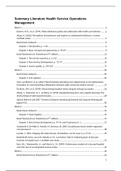Samenvatting
Summary of all the mandatory literature of Health Service Operations Management ()
- Vak
- Instelling
- Boek
Hi, This document contains a summary of all the mandatory literature of HSOM. While I read literature, I always highlight the important things and make a summary of it so I have the main message of each article. This makes it a lot easier for me to learn for the exam. Sometimes I highlight someth...
[Meer zien]





